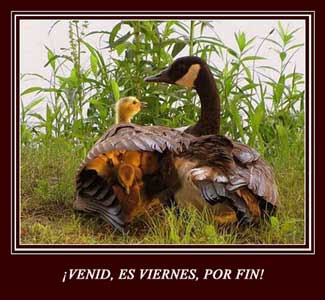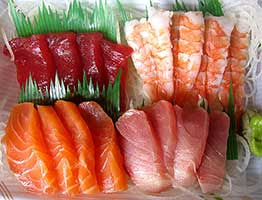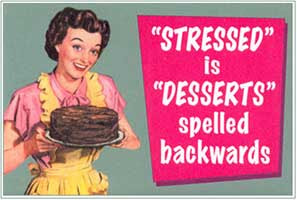
Algunos datos erróneos que yo creía verdaderos:
(Some misconceptions I believed were true:)
1. "Sushi" NO significa "pescado crudo".("Sushi" does not mean raw fish.)
 |  |
La palabra japonesa para referirse al pescado crudo es "sahimi". La palabra "sushi", en realidad, proviene del tipo de arroz utilizado, "sumeshi", aderezado con vinagre, sal y azúcar. Los acompañamientos para el arroz pueden incluir tradicionalmente pescado crudo—pero también mariscos cocidos, huevas, huevos o verduras como el pepino, rábano chino o ciruela china.
(The usual Japanese term for raw fish is 'sashimi'. The term 'sushi' actually comes from the rice used, "sumeshi", which is gently folded with a vinegar and salt and sugar dressing. Toppings for the rice may traditionally include raw fish—but also cooked seafood, fish roe, egg, or vegetables such as cucumber, daikon radish, or ume plum.)
2. El azúcar NO provoca hiperactividad en los niños.
(Sugar does not cause hyperactivity in children.) La Academia Nacional de Ciencias y la Asociación Norteamericana de Dietética no han encontrado ninguna prueba definitiva que demuestre una relación de causa-efecto entre el consumo de azúcares y la hiperactividad. Los factores que influyen en el comportamiento de los niños son psicológicos.
La Academia Nacional de Ciencias y la Asociación Norteamericana de Dietética no han encontrado ninguna prueba definitiva que demuestre una relación de causa-efecto entre el consumo de azúcares y la hiperactividad. Los factores que influyen en el comportamiento de los niños son psicológicos.
(The National Academy of Sciences and the American Dietetic Association failed to find substantive evidence to prove a cause and effect relationship between sugar consumption and hyperactivity. The factors that influence children's behavior are psychological.)
3. Einstein NO tenía malas notas en el colegio.
(Einstein did not get bad grades in school.)
 | Mueve el puntero sobre la imágen para ver la traducción (Move the pointer over this picture to see it translated) |
De hecho, era muy buen estudiante, sobre todo en ciencias y en matemáticas (como no podía ser de otra manera).
Una copia de las notas obtenidas en su examen final de secundaria, que aprobó el 3 de octubre de 1896 –a los 17 años—en Aarau (Suiza), muestra que Albert Einstein (1879-1955) era bueno en matemáticas en el instituto. Hay que resaltar que el 6 es la nota máxima que se obtenía en esa época.
(In fact, he did very well at school, especially in science and maths (unsurprisingly).A copy of Albert Einstein's matura, received on October 3, 1896 -at 17- in Aarau, shows that Albert Einstein was good at math in high school; note that 6 is the best possible mark at that time.)
4. Napoleón NO era bajito.
(Napoleon was not short.)
Existen varias teorías para explicar el apodo de "Le Petit Caporal" ("El pequeño Cabo"), pero pocos estudiosos modernos creen que se refiriera a su estatura física.
Después de su muerte en 1821, la altura del emperador francés fue registrada como de 5 pies 2 pulgadas en medida francesa. Esto corresponde a 5 pies 6,5 pulgadas según la medida actual, o sea 1,685 m, dentro de la media de altura de finales del siglo XVIII.
(There are competing explanations for why he was nicknamed le Petit Caporal (The Little Corporal), but few modern scholars believe it referred to his physical stature. After his death in 1821, the French emperor's height was recorded as 5 feet 2 inches in French feet. This corresponds to 5 feet 6.5 inches in modern international feet, or 1.686 metres, completely average for the late18th century. )
5. Thomas Edison NO inventó la bombilla incandescente.
(Thomas Edison did not invent the light bulb.) Thomas Alva Edison inventó muchas cosas –de hecho es uno de los inventores más famosos de todos los tiempos—pero la bombilla incandescente no fue uno de ellos. Fue Humphry Davy quien, en 1809, colocó una fina tira de carbono entre los dos polos de una pila, creando un fugaz arco luminoso, la base esencial en la que se basa el funcionamiento de una bombilla.
Thomas Alva Edison inventó muchas cosas –de hecho es uno de los inventores más famosos de todos los tiempos—pero la bombilla incandescente no fue uno de ellos. Fue Humphry Davy quien, en 1809, colocó una fina tira de carbono entre los dos polos de una pila, creando un fugaz arco luminoso, la base esencial en la que se basa el funcionamiento de una bombilla.
Lo que hizo Edison fue perfeccionar el invento. En 1879 inventó un filamento de carbono que permanecía incandescente durante 40 horas y lo colocó en una bombilla al vacío, creando la bombilla incandescente moderna que mejoró hasta que durara unas 1200 horas.
(Edison invented a lot of things – in fact he's one of the most famous inventors of all time – but the light bulb wasn't one of them. It was Humphry Davywho, in 1809, placed a thin strip of carbon between the two poles of a battery, creating a brief luminous arc, the essential base which underpins the operation of a light bulb. What Edison did was to improve the invention. In 1879 he invented a carbon filament that burned for forty hours and it placed it in an oxygenless bulb, inventing thus the modern light bulb which he improved until it lasted 1200 hours.)
Pero, lo que SÍ es cierto es que Andrea, una alumna, estuvo este verano en The Wizarding World of Harry Potter (del que ya os hablé), y me ha dejado unas fotos para que las compartamos con ella. ¡Gracias!
(But, what is certain is that Andrea, a student of mine, went to The Wizarding World of Harry Potter last summer, and she has left me some pictures so that we can share them with her. Thanks a lot.)
¡Feliz fin de semana!(Have a nice weekend!)















No hay comentarios :
Publicar un comentario